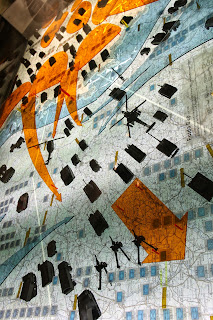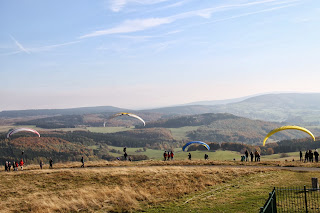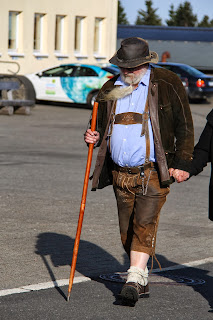The first of these tours was to Fulda Gap. Fulda Gap? Yes, that was me, too. I had no clue what Fulda Gap was...besides the obvious...as the name implies it must have something to do with a geographical gap (I supposed), and something to do with German history, but if it was a USO tour, well then it must have something to do with US history as well...hmmm, well, I figured, if nothing else, it was a chance to see an area I hadn't seen before and take some pictures (how can you go wrong with that?)
Amazingly, the tour started at a reasonable time...7 am. I could deal with that, as I have been on some USO tours that started in the middle of the night, so 7 am was doable. First stop on our journey: Observation Point Alpha.
Observation Point Alpha (different than Checkpoint Alpha as there was no transportation movement in the area, such as trains) became important because of the Cold War. On May 8, 1945 the Germans had surrendered unconditionally (WWII) but there were some problems still associated with the political views of some of the major powers involved with Germany. The United States and Soviet Union had their eye on the area with the goal of spreading their political agenda/beliefs (matter of perspective which is more appropriate) These opposing ideals literally split Germany in two, causing the Cold War, which lasted approximately 40 years. The Federal Republic of Germany was founded on May 23, 1949 and the German Democratic Republic was founded on October 7, 1949. the FRG signed the NATO treaty and the GDR signed the Warsaw Pact. With this choosing of sides the Iron Curtain divided the country creating one of the most heavily guarded demarcation lines.
As I understand it, the demarcation zone started as a "green border" where basically all the vegetation was removed making it easier to spot people attempting to illegally cross the new border. When the "green line" or "green boarder" Just wasn't working well enough the barriers became progressively more confining, being replaced by the "anti-fascist protection barrier" which was increasingly impermeable. By the end of 1946 the USSR had started to increase control of the border. There were guards on horses that rode along the green border as well as some other guards at specific locations. The control was meant not only to stop people but to also stop the flow of goods over the border. The USSR progressively started to increase the control along the border.
As time went on, restrictions tightened in the area. A lot of this happened in the early 1950s, around the same time as the Korean War. The progression of the restrictions were systematic. At first, there was a 10 meter wide section that was forbidden to enter. Then there was a 5 meter restricted zone that could only be entered by registered residents or those with special permission. Starting in 1952, people residing in the 5 meter zone who were suspected of being critical of the system were forceably moved to locations further in the GDR. During this time 11,000 people living within this 1400 km area, lost their homes. Of those 11,000 people, 9,000 were relocated to inner GDR locals, while 2,000 escaped. The operation to remove unwanted individuals from the protected zone was code named "operation vermin" making it clear what was thought of these people. Many who were moved were farmers whose farms had a long tradition in the area and their farms were leveled. Others also included Nazis.
In August 1961 the Wall was built, but in more rural areas, such as Fulda Gap, other means were used.
They went from mounted guards to adding signage.This is an example of the signage that was added. They would put up the barricade with stop sign and behind that they would place metal girders to help hinder passage.
Next they erected simple barb wire fencing on wooden posts.
When that still did not seem to stop traffic across the green line, the next step was double fencing, using concrete posts.
When that still was not enough of a deterrent, mines were placed between the fences. These were 200kg mines which were enough to kill a person. Along a 614 km strand, about a million mines were placed between 1961-1983. There were approximately 233,000 attempts to escape with hundreds of fatalities. In 1962 border duty became compulsory.
In case there was any concern about whether someone could make it through the double fenced mine area, guards on the East German side were given orders to shoot to kill anyone entering the zone.
On August 9, 1962 a truck bringing material to the border failed t stop to unload, instead the driver plowed through the barrier and stopped several meters on the Western side. The soldier driving the truck quickly jumped out and threw himself on the ground. No shots were fired, from either side. The truck and its contents were confiscated. The soldier had accomplished what he set out to do, as he was now safely in the West.
This seems to have started a domino effect of events that caused more restrictive implementation. Since the truck made it through from east to west, the GDR was determined to increase their control. On August 14, 1962, a GDR captain (Captain Armstadt) fired on a group of west German border guards. In turn the west German guards returned fire, killing the captain. Of course after this happened there was the typical finger pointing...the GDR said that the Western border guards were on GDR soil and that the west Germans shot first; the West Germans maintained that they shot in self-defense. Whichever may be true, Captain Armstadt was hailed as a hero on the GDR side. As it turns out, the marksman who shot and killed Cpt Armstadt took a job as a taxi driver after the unification, and was found murdered in his taxi (some speculate that this was revenge, but the case was never solved).
The altercation created two things, the no man's land (a section of land which was just between the GDR barricades and the border going into the west. To alleviate the possibility of accidentally shooting a guard on the opposite side, GDR guards would shoot at anyone going within the area at an angle, thus limiting the chance of "accidentally" hitting a guard on the other side. The second was that in 1968 the US forces took over the responsibility of border surveillance from the German border guards and Observation Point Alpha was created.
While this was going on, fortification of the border was still progressing. To add to the already erected mine fields, specially trained dogs were also used. They were trained to kill on command. (after the reunification, these animals had to be destroyed as they could never be redomesticated).
 |
| Guard dogs prohibited unobserved access to open ground or potential escape routes. Besides areas where dogs were tethered to long line, there were also fenced in areas where dogs could run freely. |
Metal fences were also installed. These fences extended several meters (approximately 3 meters) above ground, but were also embedded several meters, to deter digging under them.
To make them even more effective, splinter mines or spring guns were installed on the fencing. These splinter mines were facing the GDR. The antipersonnel fragmentation mines were mounted at three different heights on every fourth cement post. The mines would explode on contact (the mine as a 110 gram load of TNT that shot out 80 steel splinters). The splinters were propelled up to 30 meters. These were self shooting devices that would ultimately either kill or permanently injure deserters.
To deter the use of vehicles to break through the border barricades, anti-vehicle trenches were installed...basically tall concrete walls that were both above and below ground, stopping vehicles from being able to pass.
About 500 meters in from the border barriers was a second border fence system. This fence was equipped with sensors that would silently set off alarms at nearby observation towers. Effectively, anyone setting it off could be shot before nearing the actual border barriers.
The entire border (approximately 1400 km) was lined with a double-laned concrete surface that was only used by official vehicles of the GDR border patrol. (it was built in 1965)
 |
| part of the concrete road. DDR is the same as GDR. |
The guards from each side could easily see the other side.
 |
| The tower on the right was on the East German side, the tower on the left was US forces Observation Point Alpha |
 |
| GDR tower |
 |
| Observation Tower BT9 (built in the mid-70s ) on the West side. |
The 14th Armored Cavalry Regiment originally was assigned for border surveillance in 1951. They were replaced by the 11th Armored Cavalry Reginment (Blackhorse)
Service at OP Alpha was not an easy assignment. Fulda Gap was the assumed crossing point for Soviet Forces if they decided to be aggressive Because of the isolation that came with serving at OP Alpha and the stress associated with the assignment, members only served in the area for about four weeks and then were replaced. Their duties were primarily to maintain equipment and radio transmission disposition. The normal contingent strength of the OP was 40 men, but in a crisis situation 00 could be deployed to serve at OP.
 |
| These signs alerted US soldiers that they were getting very close to the "edge of the frontier of freedom" |
 |
| The US flag still flies at Observation Point Alpha. The pole itself does not touch the ground as a sign that American soldiers were there to protect and had not taken possession of the land. |
 |
| This birch cross was erected after a terrible scene was witnessed by US troops. The cross was erected and stands for all those who became victims of the German division. |
 |
| Relaxing looking out over the gap. |
 |
| Memorial of German division and reunification |
After touring Point Alpha we proceeded on to the Wasserkuppe. The area has history in aviation going back to 1911 but during the Cold War the Radome (and others) were used for radar. The Wasserkuppe (water summit) is a plateau and is the highest location of the Rhon Mountains in Hessen. It is known for its contribution to aviation, particularly glider planes. With its updrafts and space it is still used for glider planes, RC planes, and paragliding. The area also has thousands of km of hiking trails and a summer toboggan run..
We happened to take a tour of the Radome. This was originally one of the radar domes erected on Wasserkuppe, but the German Air Force has since abandoned use and only one dome remains. It is used for many activities. You can climb up and walk around the dome getting spectacular views, but they also have concerts which are held in the dome. The acoustics are amazing.
Pictures on the way up to the dome:
a few from in the dome:
Other pictures from the plateau:
 |
| Rosemary on the observation deck. |
 |
| Diggin' the rainbows on the glass. |
After spending a while on Wasserkuppe, we went on to Kloster Kreuzberg. I really have no clue what this had to do with the Cold War, other than that there were transmission towers located there (on Kreuzbeg that is). At any rate, the monastery is a Franconian monastery that happens to brew beer...unfortunately it is dunkel (dark) beer, and I just wasn't in the mood for dark beer, so didn't try it...now I wish I had bought a bottle to try later (it was served in steins, but you could buy some in bottles to take with you). So here are some pictures from that area.
 |
| The monastery has a pair of St. Bernards. They actually had puppies this year but all had been sold (for a hefty price from what I understand). |
Had I known what the stops were for this trip, I may have had second thoughts on it, but all in all it was ok. I did finally figure out one connection they all had to the Cold War and Fulda Gap. Fulda Gap is made up of three districts (state basically for those from the USA); Hessen, Thurligen, and Bavaria. This tour included something from each of these three districts; Hessen was Point Alpha, Thurlingen was Wasserkuppe, and Bavaria was Kloster Kreuzberg.





































































































_9596.jpg)
No comments:
Post a Comment